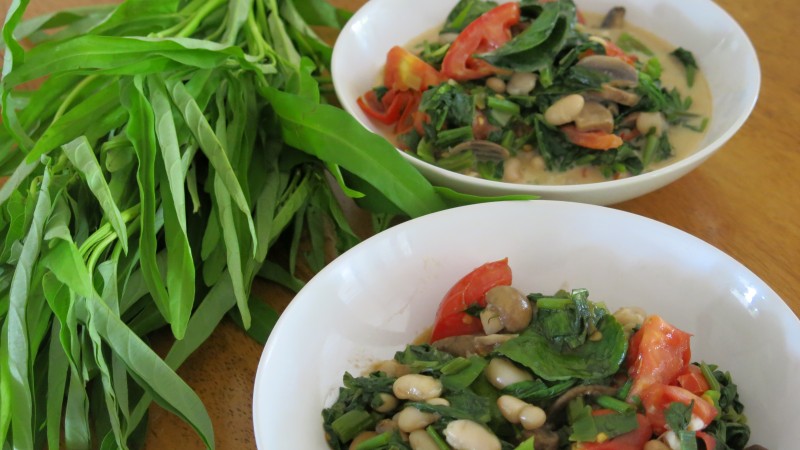I was first introduced to kang kong (pronounced kang kung) ten years ago when I went to Timore Leste for my brother and sister in law’s wedding and instantly fell in love with it’s subtle flavours. Kang kong is now becoming more and more popular with growers in our region and I am overjoyed. It is a brilliant substitute for kale and other leafy greens and grows more easily than kale in our area due to the wet weather.
Kang kong also known as water spinach, swamp cabbage, ong choy, Chinese watercress, pak bung, pak bong, rau muong, kolishak is widely used in South East Asian countries, the South of India, Bangladesh and West Bengal. There is something about kang kong that just makes me feel good. It does contain iron and some protein and is high in vitamin c and k, it also contains other vitamins and minerals but is not up there in the super food department. However when I eat it I feel my body sing as it feels so good to eat, is tasty and leaves me feeling refreshed and overall happy. It is extremely easy to prepare and the farmers who grow it in our region love it as it is an easy crop for them to grow. Ian one of the farmers lights up when he is able to tell me he has kang kung available, as for a few years, he struggled to get people to buy it as they were fixated on buying kale.
I use kang kong as a substitute for other leafy greens so if I can’t get silverbeet, kale or spinach I use it in recipes that call for those vegetables. In addition kang kong has some great recipes all of its own. The mustard green sambal in the Balinese section of my book works really well with kang kong. For a spicy brunch wash it and chop it roughly, heat it up in a dry frying pan for a few minutes, add some freshly chopped chili and gluten free tamari and serve with oven roasted mushrooms and tomatoes. Wilt it first and pop it in an omelette. Add it to your smoothies, curries and stews.
The stems are chewy and I like them like that. The bottom of the stem can be woody so chop that off and the below recipe is wonderful with organic basmati rice or millet .
If you live in an area where kang kong is not easily grown then you can use any of the Asian greens for the below recipe or if in Europe try it with kale and if you can’t get kaffir lime leaves use the zest of a lime or lemon. It can be made two ways; with or without the coconut milk. Both ways are equally as nice.
Kang kong with white beans – dairy free & gluten free
- 1 Spanish onion finely chopped
- 2 garlic cloves minced
- 2 tsp of finely grated ginger
- 6 kaffir lime leaves
- 2 tomatoes diced
- 1 bunch kang kong washed and shredded (not too finely)
- 300g mushrooms sliced thinly or 300g exotic mushrooms sliced the way you like them
- big splash of tamari
- 2 finely chopped chillies (optional)
- 400 g cooked cannelini beans
- salt to taste
In a wok splash the oil of your choice sautee the onion, garlic, ginger and kaffir lime leaves for two to three minutes then add the tomatoes, mushrooms and chilli (if using), for a further minute next adding the kang kong. Cook until the kang kong is wilted then add the cannelini beans and tamari, coconut milk if using. Heat through but don’t bring to the boil and add salt to taste.

